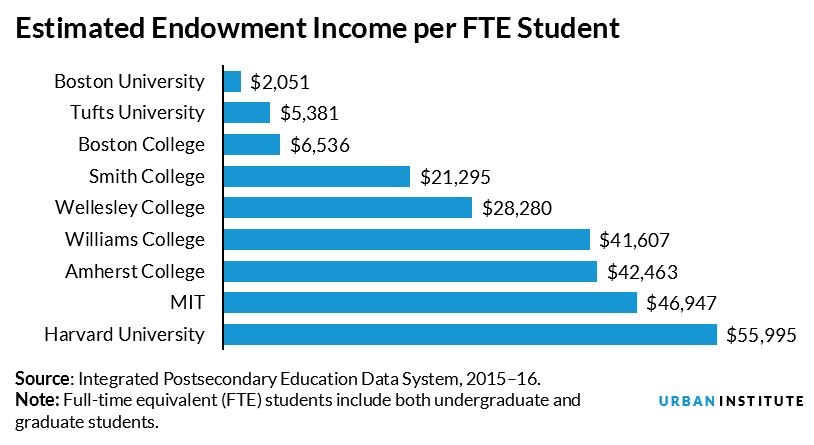
<p>People read atop the columns in front of Harvard University's Harry Elkins Widener Memorial Library on July 3, 2017 in Boston, MA. Photo by Page Light Studios/Shutterstock.</p>
The idea of taxing large college and university endowments has found favor with both the Trump administration and, perhaps suprisingly, Massachusetts Democratic gubernatorial candidate, Jay Gonzalez.
Colleges and universities adamantly disagree with these proposals, arguing that they provide large public services that should be tax exempt. Massachusetts provides a great case study for assessing both sides of the issue and illuminates the trade-off between raising funds for public goods and taking money away from institutions that provide services to students and the public.
What are college and university endowments?
Endowments are the financial assets that colleges and universities hold and invest. The returns (incomes on these investments) provide long-term funding for financial aid, facility operations and maintenance, and faculty salaries. Although both public and private nonprofit colleges and universities hold endowments, the most selective private nonprofit institutions tend to have significantly higher endowments.
In fact, 25 institutions hold half of all endowment assets in the United States. The median private nonprofit college had an endowment income (or return) of $2,400 per student in the 2013–14 school year.
In December 2017, Congress passed the Trump administration’s tax reform bill, including a 1.4 percent tax on the income of college and university endowments for schools with at least 500 students and an endowment greater than $500,000 per full-time student, moving away from a long-standing precedent of providing tax-exempt status to universities.
Gonzalez tax could increase K–12 budget by 8 percent
In September, Gonzalez proposed a 1.6 percent tax on all (Massachusetts) private nonprofit college endowments over $1 billion. Unlike the federal tax, which taxes only the income on the endowment, the Gonzalez tax applies to the endowment’s entire value.
This proposal would affect Amherst College, Boston College (BU), Boston University (BU), Harvard University, the Massachusetts Institute of Technology (MIT), Smith College, Tufts University, Wellesley College, and Williams College.
Assuming institutions make no changes to their endowment structures, I estimate that the proposed tax would raise just under $1 billion in annual revenue (based on 2015–16 endowment values). Gonzalez has proposed using this money for K–12 education, public higher education, and public transit budgets. If the entire tax revenue were contributed to K–12 education, the state’s K–12 budget would increase 8 percent.

How does an endowment’s size affect students?
Total endowment funds subject to the tax range from less than $2.5 billion at Amherst, BC, BU, Smith, Tufts, Wellesley, and Williams, to $13.2 billion at MIT and $35.7 billion at Harvard. But endowment size alone does not determine the resources institutions have to spend on their students.
Assuming a 4 percent return on endowment investments (consistent with common university policies limiting endowment spending to between 4 and 5 percent of the endowment’s value), the institutions subject to tax under the Gonzalez proposal have estimated endowment incomes ranging from $2,051 per student at BU to $55,995 per student at Harvard. These restricted and unrestricted funds are spent directly on student aid and on college operations.

Low-income students pay less at schools that would be subject to tax
Colleges and universities argue that they provide critical public services that should be tax exempt. These services include providing large amounts of financial aid to low-income students, educating the public and future leaders, and providing research that contributes to medical discoveries.
One measure of how institutions are serving the public is the number of low-income students that enroll. A crude measure of the number of low-income students is the number of students who qualify for federal Pell grants. Approximately 1 in 10 students at Harvard qualify for federal Pell grants, compared with 1 in 5 at Smith and Amherst. Nationally, high-endowment institutions enroll relatively few low-income students, and the highest-endowment schools tend to be highly selective.
Although high-endowment schools tend to enroll relatively few low-income students, low-income students who enroll pay lower net prices than at low-endowment schools. Though we can’t know how much a university uses its endowment income to subsidize low-income students, we can see how much these students pay at high-endowment schools compared with low-endowment schools.
The average Harvard student from a family earning less than $48,000 a year pays less than $2,400 a year. Except for BU, all the schools that would be subject to tax under the proposal have an average net price of less than $10,000 a year for students from families that earn less than $48,000. The generous financial aid given to many low-income students is made possible in part by income from endowments.

There is a trade-off to the decision to tax college endowments. Colleges and universities with high endowments can use the income from these endowments for important services, including subsidizing cost of attendance for low-income students.
But Gonzalez’s proposed endowment tax could provide $1 billion in additional funding to Massachusetts for critical services, including public K–12 and higher education and transportation. Or maybe this trade-off is unnecessary and the state can find other ways to raise the funds without taxing colleges and universities—the 4 percent tax on individual income above $1 million (proposed as a Massachusetts ballot initiative) would raise twice as much.
Let’s build a future where everyone, everywhere has the opportunity and power to thrive
Urban is more determined than ever to partner with changemakers to unlock opportunities that give people across the country a fair shot at reaching their fullest potential. Invest in Urban to power this type of work.